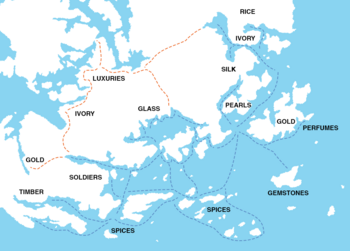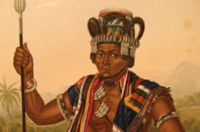Pearl Road

The Pearl Road or Pearl Route refers to an ancient maritime trade network that connected several important parts of southern Europa on Eurth. This long-distance network enabled much greater economic interaction between peoples from Azania, Amutia, Meteorola, and the Orient. As a side effect, these increased exchanges led to a more unified, shared culture among these nation states.
Etymology
The name of the ancient maritime trade network comes from of the black Tamurine pearl. This gem has long symbolised wealth, mystique, and adventure across various cultures. Much like the enigmatic journey of the pearl from the depths of the sea to the light of human admiration, the Pearl Road represented a voyage of discovery, trade, and cultural exchange. The black Tamurine pearl, renowned for its dark, iridescent hues, originates from the warm waters of the Tethys Sea. These pearls are cultivated in the black-lipped oyster (Pinctada tamurinea), a species that imparts the pearl with its unique colour and lustre. The rarity and natural beauty of these pearls made them highly prized possessions, often associated with luxury and exclusivity.
Drawing a parallel to the Tamurine pearl's journey from a simple mollusc to a symbol of elegance resonates with the transformative power of the Pearl Road. The Pearl Road was a conduit for rare and valuable commodities, facilitating the exchange of goods, ideas, and cultures among distant lands. The name 'Pearl Road' not only reflects the physical movement of precious goods, including pearls, along the route. It also symbolises the transmission of knowledge, art, and traditions that enriched societies far and wide. The trade network was not merely a series of maritime routes but a catalyst for social and economic progress. It connected diverse civilisations, fostering an environment where innovation and cultural blending thrived. The term 'Pearl Road', therefore, embodies the essence of connectivity and growth. It signifies the integration of various cultures along the trade routes, much like the layers of nacre that form the Tamurine pearl. The pearl's journey from the depths of the ocean to becoming a cherished ornament mirrors the evolution of societies that were part of the Pearl Road – isolated communities transforming into cosmopolitan hubs of trade and cultural exchange.
History
The Pearl Road was established in the 2nd century CE. Evidence of these movements can be seen in shipwrecks recovered in the Rivdon Bay and Rosario Sea, which contained trade items from faraway regions. It wasn't exactly one single unified trade network, but rather a patchwork of overlapping local trade networks. Nations and city-states along the Pearl Road centred their economies on both sea and land. Indigenous slaves were the backbone of this early pearl fishing industry in the Orient. Trade in the rest of Europa was facilitated through roads and river networks. Roads and rivers could be controlled by different lords, who would then extract tolls from any merchants who used them. No monarch owned the seas or could regulate and tax the sea. So commercial activity began to spread among the common people, unrestricted by the aristocracy.
If you wanted to take part in the Pearl Road network, all you needed to do was build a boat, load what you had to sell, and set out into the sea. The trade route included crossing several bodies of waters skirting the Oriental Ocean and Adlantic Ocean, but not yet into the open ocean. The Pearly gates was an informal name for the strait between Tamurin and Orioni, a term later repurposed by some early Christians.
During the 6th century, due to the social and religious upheaval among the Shakyan Principalities, the coastal Sokhainean people were pushed out by the neighbours. They fled to the Southern islands of the Peridasei Archipelago, culturally absorbing the native Azano-Marenesian Vahishtoang civilisation, thereafter forming the largest ethnicity in modern day Safiloa.
By the 9th century, Ayubi became one of the final links in the Pearl Road. During the 15th century, multiple Orinese fleets under Admiral Jovan Tafari began raiding along the Pearl Road.[citation needed] This eventually led to the creation of a large Orinese colonial empire, which attempted to supplant almost the entire network. In the mid-16th century, a chartered company managed by Jivanamist Tamurini merchants and farmers established an export-based colony. Their exports were mostly based on sea salt panning, limestone mining, and spice farming on the island of Maleibidulu. The island was besieged by a series of plagues and pillaged by raiders several times. This decimated the native Marenesian population. During the 17th century, Iveric refugees sent explorers into the eastern part of the Pearl Road in preparation of their Gran Viatge or the “Great Voyage” towards the New Wurld.
Routes
Clockwise from east to west, this maritime trade route connected:
- Jasmine Sea trade by the Shakyan principalities.
- Paraia Bay trade by the Three Kingdoms.
- Oriental states such as Tamarini and Orioni.
- Overlap with the local Miirosi trade connections.
- The Meteorolan archipelago.
- Ancient Hakenian maritime trade network around the Memopotamian peninsula.
- Intra-Azanian trade.
Notes
- ↑ OOC. Inspired by the Oxus Treasure#Vessels.


